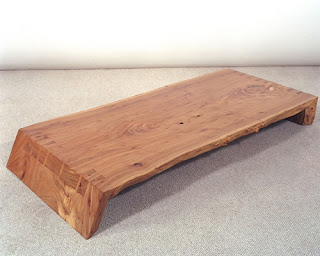

In a way, this blog is dedicated to a great craftsman named Eric Manigian. I was asked to cover the BKLYN DESIGNS trade show by @home magazine, and chose his work to feature in the magazine out of hundreds of others. I really loved his work. Later, he and I had a great telephone conversation, and he said I seemed to have a better grasp of Design principles than most people he speaks to about what he does. I hear that from a lot of designers and architects (you can't imagine the pride in hearing "that's exactly what I was just going to say!" or "you totally get where I'm coming from!"), but from him it sounded so sincere.
The following year, he had a booth again, and he suggested that I really should start a blog. I told him I do have a LiveJournal where I discuss a lot of the things I've seen, but I thought it was time to take his advice and start a blog devoted purely to these topics. And so, Architextures by Ryan Witte was born.
Here is the section of my article, as published in @home, about the work of Eric Manigian. [A lot of this is copied from other sources, so please disregard the lame formatting. This is also a highly edited-down version of my original piece, due to page space limitations.]
Eric Manigian’s work speaks for itself, but that’s sort of the point. It’s all about Honesty. His work had always been about the relationship with the trees and the wood he uses to create furniture, even before people started labeling his work “Green.” He explained that with hidden joinery, there are shortcuts a craftsperson can take. Having spent time in Japan studying at a Buddhist monastery and learning the techniques of wood-frame temple construction there, he returned home with a renewed attitude toward his work.




Working with mills that salvage fallen or diseased trees, these designs respond directly to an ecological sensitivity. Manigian’s work shows his respect for trees, but as he speaks of it, he doesn’t get all plaid-flannel-shirt-and-Birkenstocks about it.


Manigian understands that in order to make beautiful furniture, he must alter the material in some way. It will necessarily show the hand of the designer. He responds to the material and then forms the piece, rather than trying to force it into some predetermined shape. Exposed joinery is part of the design. His work displays an uncommon level of care and attention to his craft; as if slapping two pieces of wood together with a couple of hidden screws does the natural wood a disservice. You’ll notice that the joinery is not just basic, bland woodwork. He staggers his joints, giving them voice and aesthetic purpose. They’re perfect, smooth, seamless.


He stains nothing. He’s actually had clients who didn’t understand his work ask for a piece to be stained darker, and he’s all but flat-out refused. The staining process contradicts his vision, but even just aesthetically, ruins the natural beauty of the material by homogenizing the texture, destroying the look of the grain, making its natural striations more uniform.

Eric Manigian Studio
Brooklyn, NY
718.855.9097
©2006, Ryan Witte
4 comments:
I too have seen Eric's work close up and was amazed by his artistry and attention to detail. He truly
shows his admiration for the wood by obviously spending an enormous amount of time on each piece.
We need more artists and craftsmen to follow Eric's lead in extending the life of one of nature's greatest resource.
It's true, the great tradition of the craft of making furniture is almost lost in this day and age. It's inspiring to see someone who takes such great care in his work.
It is beautiful work! I wonder if he uses a oil finish since it appears to have a finish and not just raw wood.
Here's what Eric said in response:
Yes, the finish is multiple layers of a Tung Oil and Marine Varnish mixture and polished with Carnauba Wax.
For some reason wood workers in the past have kept their finishes guarded, but I don’t see why.
I learned this formula from the great Sam Maloof, but I’ve made my own modifications to it.
It is, of course, labor intensive like everything else I seem to do… : [
To put a proper finish on a piece takes a full week.
Post a Comment